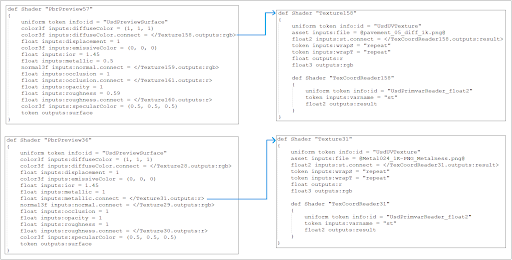USDZ ファイルは、ジオメトリ、テクスチャ、マテリアルなど、モデルに必要なすべての要素を 1 つのファイルにパッケージ化した 3D 形式です。 また、USDZ は、粗さや金属度などの PBR (写真ベースのレンダリング) テクスチャ マップもサポートしており、リアルなビジュアルの作成に役立ちます。
USDZ は、VFX や拡張現実のワークフローで広く使用されています。 USDZ ファイルを使用する主な利点は次のとおりです。
- モデルのすべてのパーツが 1 つにまとめられているため、共有や表示が容易です。
- リアルタイム表示用に最適化されており、互換性のあるデバイスでスムーズに表示できます。
- USD 形式をベースに、すべてがすぐに使えるようにパッケージ化されています。
USDZ は、リアルなレンダリングが重要なアプリケーションで高品質の 3D アセットを共有するのに理想的です。
USDZ ファイルのインポートとエクスポート
USDZ ファイルを SketchUp にインポートするには、以下の手順に従います。
- File (ファイル) > Import (インポート) を選択します。
- インポートする .usdz ファイルを見つけて選択します。
- (オプション) Options (オプション) をクリックします。 デフォルトでは、Preserve Drawing Origin (図面の原点を保持) が選択されています。 このオプションは、元のファイルの原点を使用してファイルをインポートします。 インポート時に図面の原点を保持しない選択も可能です。 OK をクリックして続行します。
- Import (インポート) をクリックします。
モデルを USDZ ファイルとしてエクスポートするには、次の手順に従います。
- File (ファイル) > Export (エクスポート) > 3D Model (3D モデル) を選択します。
- ファイルを保存する場所に移動します。
- ドロップダウンリストから、USDZ File (*.usdz) (USDZ ファイル (*.usdz)) を選択します。
- 必要に応じてファイル名を変更し、Export (エクスポート) をクリックします。
マテリアルを USDZ ファイルとしてインポートおよびエクスポートする
マテリアルをインポートするには、SketchUp のリーダーを使用します。 SketchUp のリーダーは、マテリアルをインポートするときに、マテリアルの種類に基づいて拡散色を決定するのに役立ちます。 マテリアルにテクスチャが適用されている場合、拡散色は純粋な白に設定されます。 それ以外の場合は、指定した拡散色が使用されます。
SketchUp は、拡散色に 0.5 の係数を掛けて、環境色と鏡面反射色を計算します。 放射色は常に黒に設定されます。 リーダーは、物理ベース レンダリング (PBR) を使用して、マテリアルに適切な金属度、粗さ、アンビエント オクルージョンの値、およびマップを抽出します。
USDZ ファイルでは、リーダーがシェーダー設定に基づいてマテリアル プロパティを次のように抽出します。
- diffuseColor (拡散色) – 拡散色とマップ
- normal (法線) – 法線マップ
- opacity (不透明度) – 不透明度マップとアルファ値
- displacement (変位) – 変位の強度とマップ
- roughness (粗さ) – 粗さの値とマップ
- metallic (金属度) – 金属度の値とマップ
- emissiveColor (放射色) – 放射色とマップ
- specularColor (鏡面反射色) – 鏡面反射色とマップ
- occlusion (オクルージョン) – オクルージョン マップと強度
- clearcoat (クリアコート) – クリアコートの厚さマップと値
- clearcoatRoughness (クリアコートの粗さ) – 粗さのマップと値
- ior (屈折率) – 屈折率のマップと値
SketchUp のライターは、拡散色と不透明度の値に加えて、PBR マップを処理します。 USDZ ファイルでは、ライターは以下のマテリアル特性を保存します。
- diffuseColor (拡散色) – 拡散色とマップ
- opacity (不透明度) – 不透明度マップ
- normal (法線) – 法線マップ
- displacement (変位) – 変位マップに関連付けられた変位の強度
- roughness (粗さ) – 粗さの値とマップ
- metallic (金属度) – 金属度の値とマップ
- emissiveColor (放射色) – 放射色とマップ
- specularColor (鏡面反射色) – 鏡面反射色とマップ
- occlusion (オクルージョン ) – オクルージョン マップに関連付けられたオクルージョンの強度
- clearcoat (クリアコート) – 厚さマップに関連付けられたクリアコートの厚さ
- ior (屈折率) – 屈折率マップに関連付けられた屈折率の値
以下は、USDZ ファイルのスナップショットで、書き込まれたマテリアルのプロパティを示しています。
